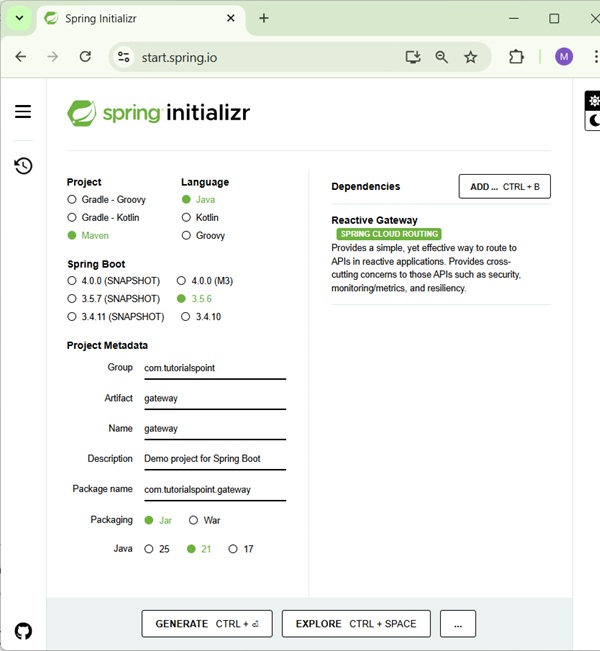
Service Discovery
- Service Discovery Using Eureka
- Spring Cloud - Creating Eureka Server
- Spring Cloud - Creating Eureka Client
- Eureka Client Consumer Example
- Spring Cloud - Eureka Server API
- Spring Cloud - Eureka High Availablity
- Spring Cloud - Eureka Zone Awareness
Synchronous Communication
- Synchronous Communication with Feign Client
- Spring Cloud - Feign Client with Eureka
- Spring Cloud - Testing Feign Client
Synchronous Communication
- Spring Cloud - Gateway
- Spring Cloud - Creating Gateway Application
- Spring Cloud - Testing Gateway Application
- Spring Cloud - Monitoring Gateway Application
Miscellaneous
- Spring Cloud - Load Balancer
- Circuit Breaker using Hystrix
- Streams with Apache Kafka
- Distributed Logging using ELK and Sleuth
Spring Cloud Useful Resources
Spring Cloud - Creating Gateway Application
The Gateway Server is bundled with Spring Cloud dependency. You can download the Spring Boot project from Spring Initializer page https://start.spring.io/ and choose the Zuul Server dependency.

You will have to add the Spring Cloud Starter Gateway and dependency in our build configuration file.
Maven users will have to add the following dependency in your pom.xml file −
<dependency> <groupId>org.springframework.cloud</groupId> <artifactId>spring-cloud-starter-gateway-server-webflux</artifactId> </dependency> <dependency> <groupId>org.springframework.cloud</groupId> <artifactId>spring-cloud-starter-netflix-eureka-client</artifactId> </dependency>
Example - Gateway Application
Once you open the downloaded spring boot project as mentioned above, we need to update source code as below −
We are annotating with @EnableDiscoveryClient because we want to use Eureka service discovery.
GatewayApplication.java
package com.tutorialspoint.gateway;
import org.springframework.boot.SpringApplication;
import org.springframework.boot.autoconfigure.SpringBootApplication;
import org.springframework.cloud.client.discovery.EnableDiscoveryClient;
import org.springframework.cloud.gateway.route.RouteLocator;
import org.springframework.cloud.gateway.route.builder.RouteLocatorBuilder;
import org.springframework.context.annotation.Bean;
@SpringBootApplication
@EnableDiscoveryClient
public class GatewayApplication {
public static void main(String[] args) {
SpringApplication.run(GatewayApplication.class, args);
}
@Bean
public RouteLocator myRoutes(RouteLocatorBuilder builder) {
return builder.routes()
.route(p -> p
.path("/customer/**")
.uri("http://localhost:8080/customer-service"))
.route(p -> p
.path("/restaurant/**")
.uri("http://localhost:8080/restaurant-service"))
.build();
}
}
application.properties
Let us write a simple configuration for the Gateway for our Restaurant and Customer service.
spring.application.name=restaurant-gateway-service server.port=8084 eureka.client.service-url.defaultZone=http://localhost:8761/eureka
Points to note about the above configuration −
We have enabled the discovery.locator to ensure that the gateway can read from the Eureka server.
We have used Path predicated here to route the request. What this means is that any request which begins with /customer would be routed to Customer Service and for /restaurant, we will forward that request to Restaurant Service.
Now our Gateway application is ready for testing which will perform in next chapter.